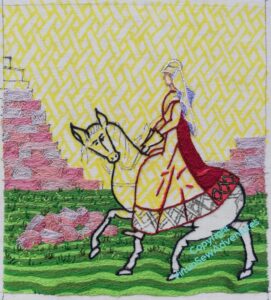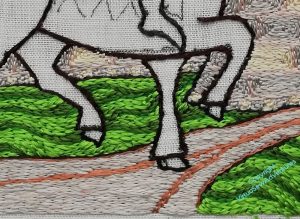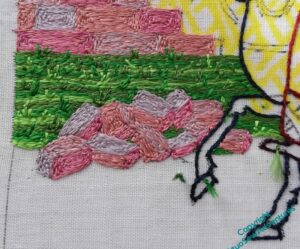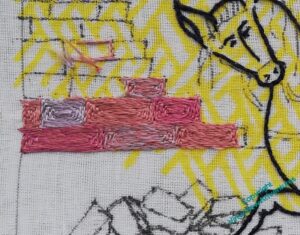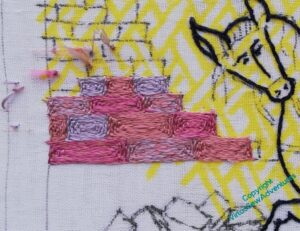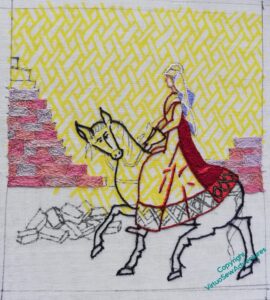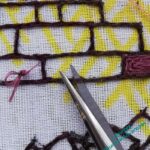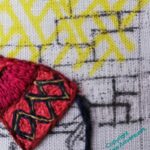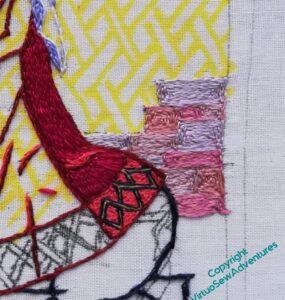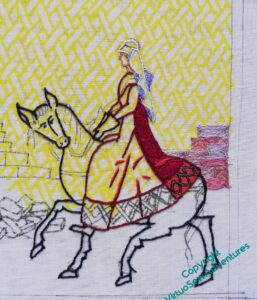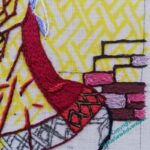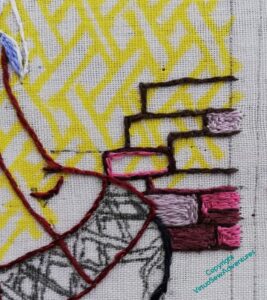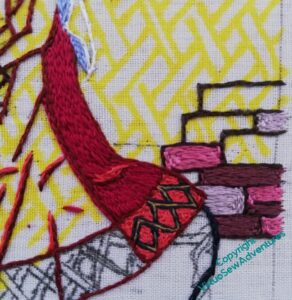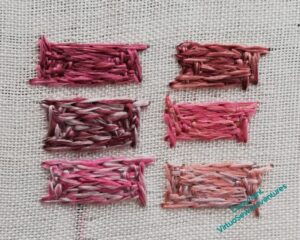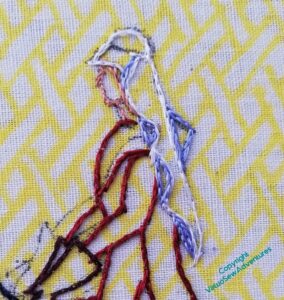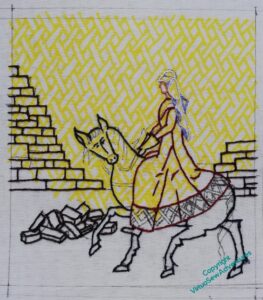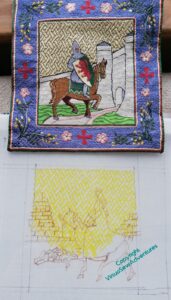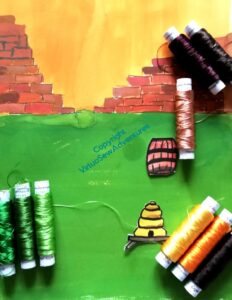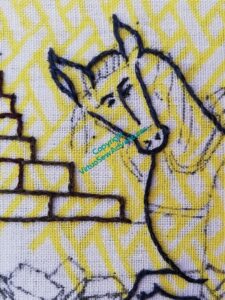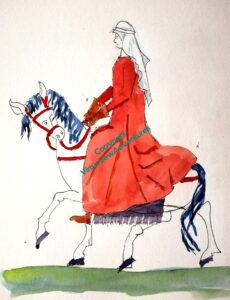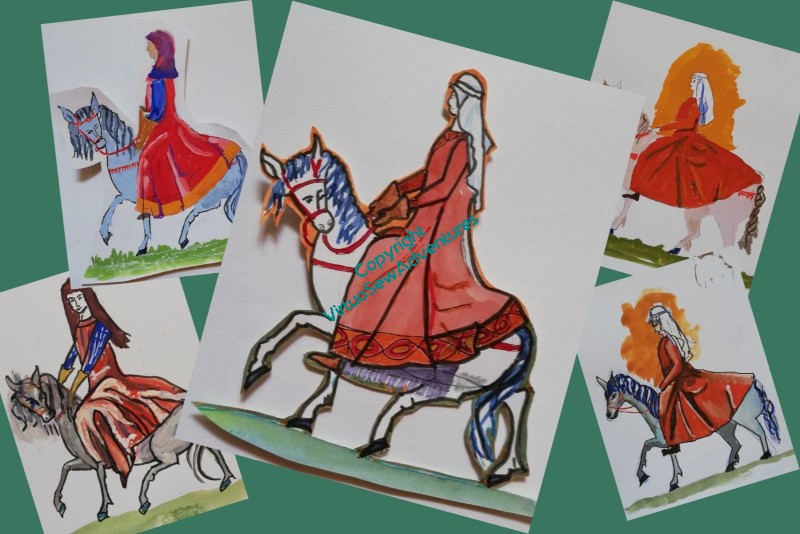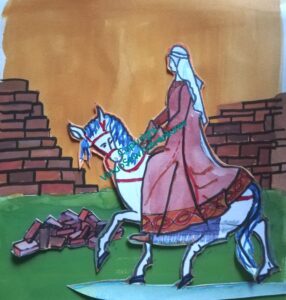Tag: Opus Anglicanum
I’ve not forgotten Aethelflaed…
… although I will admit that sometimes I don’t manage to fight away all the things that get between me and my frame at a time of day when I have any chance of stitching her sensibly!
However – I’ve done the grass!
Well, I stopped doing tussocks when I thought I might want to do more extensive tussocks in the foreground, and decided to do the horse first, in case I wanted seedheads nodding over its legs. But apart from the tussocks, the grass is done.
However, that means I now have a decision to make…
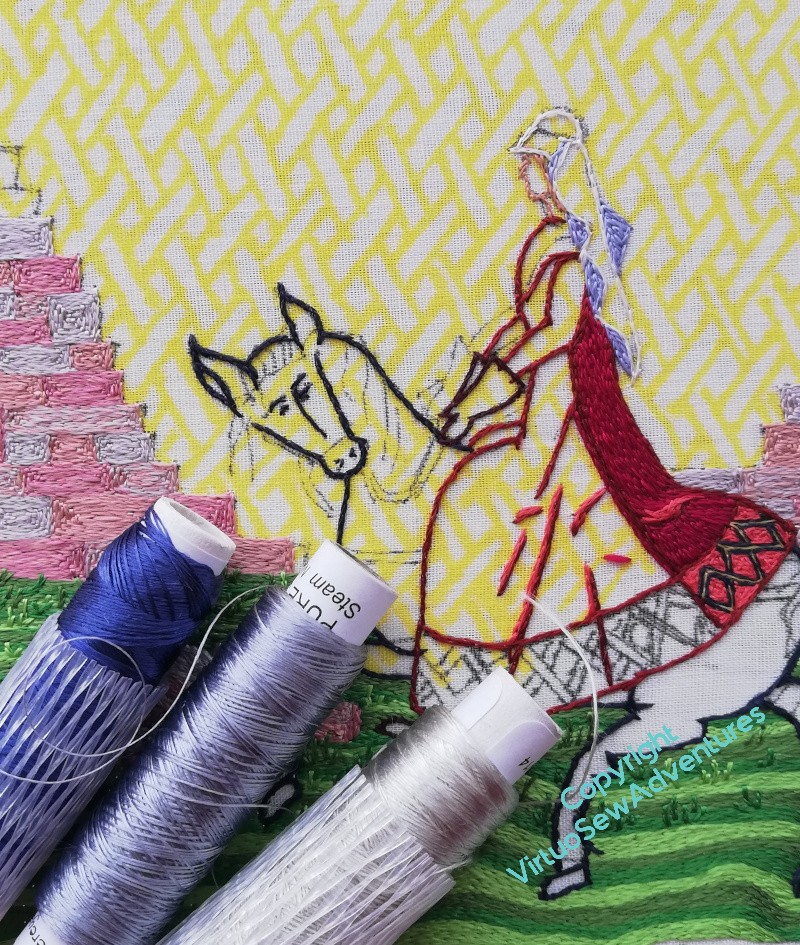
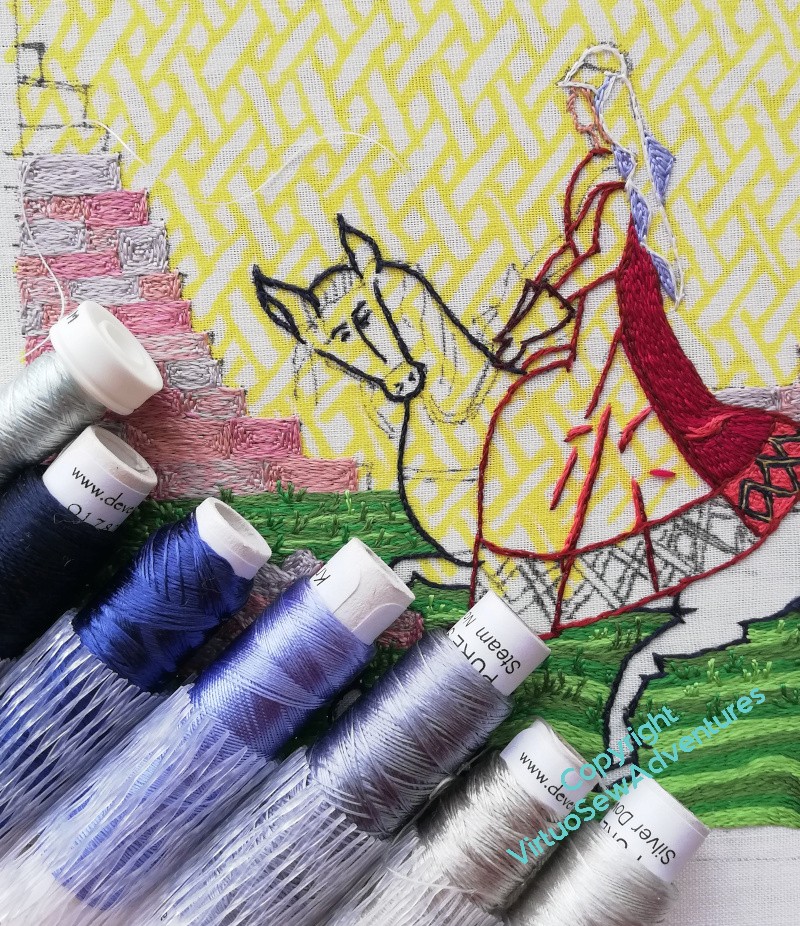
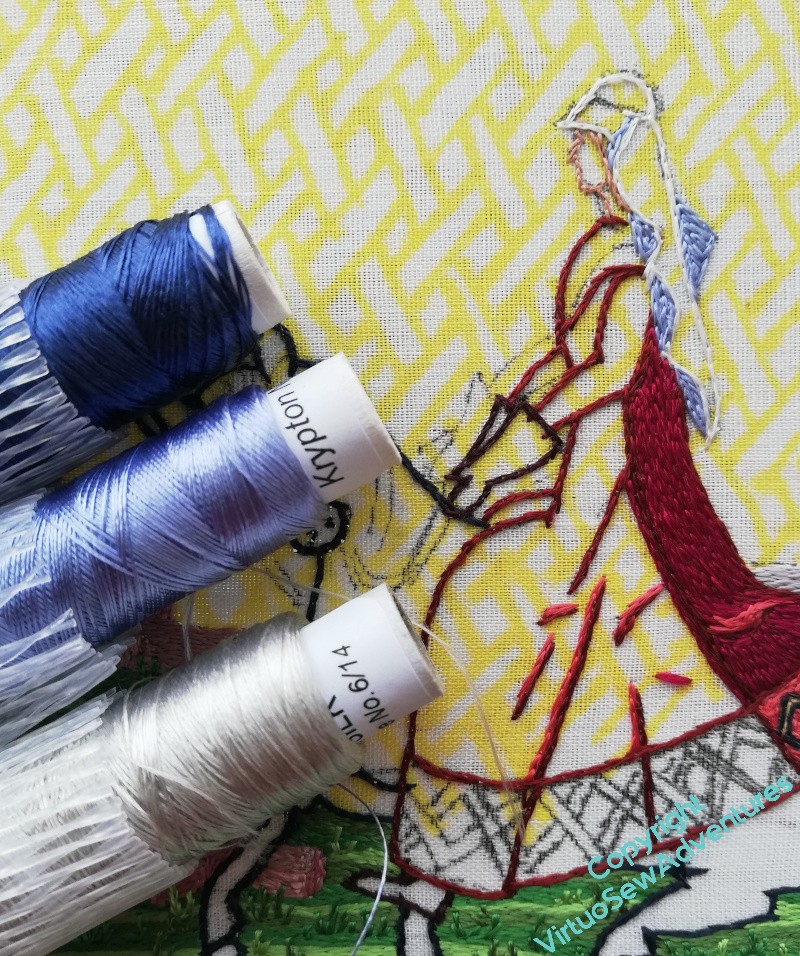
I’ve decided she’ll be mounted on a grey (contrasting with William The Marshall’s chestnut), and that it will be grey tending to blue. But which blue, and how much blue, and what colour should the lightest shade be? This is going to be important, as I think I’m not going to do dapples this time, just shading and a smooth coat.
Some thinking required…
Tackling Stones And Tussocks
You may recall that when I was stitching William Marshall, I chose to use more strands of silk in the needle, and to stitch relatively calm curves and unevennesses in the ground. I wanted to suggest that William’s kinsman kept the land around the walls of his stronghold close clipped (by grazing, one presumes) so as to ensure that he could not be take too much by surprise, whether by welcome or unwelcome visitors.
Aethelflaed, of course, is visiting, in effect, a building site. She has no road, and her horse is picking its way around heaps of building stone and over grass that’s tussocky and and uneven. I gave some thought to the question of how to represent that, staying true to the aesthetic, using only silk and split stitch, but creating some of my own variations. After all, this is modern, inspired by the past, not a reconstruction of an existing piece. I have a little freedom of movement here!
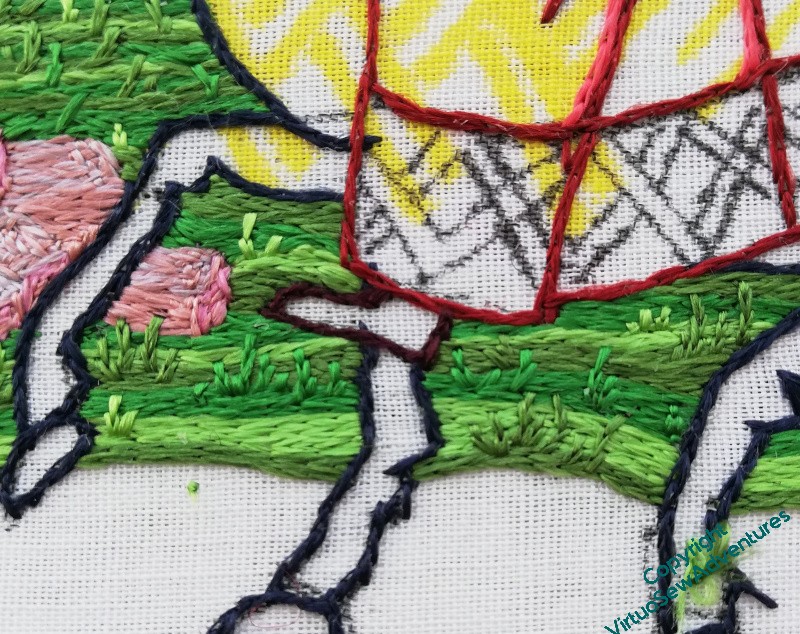
So I’m using three different greens, and I’ve not increased the thickness of the silk in my needle. I’m not stitching the curves quite as regularly, and I’ve devised a way to stitch little tussocks at uneven intervals across the ground. They are just little groups of split stitch lines crossing the flows of colour, but I think they are working rather well so far.
It has only just occurred to me, however, that I may have a slight tweak to make in my process for doing them, as I come forward: they need to get bigger, cross more of the lines of colour. Do I now just put the colour in, so that small tussocks don’t compete visually with large tussocks, or do I just carry on regardless?
Now, a reminder that I shall be giving a talk for the Embroiderers Guild on June 3!
I believe I’ve turned this image into a link to the Eventbrite page, and for anyone not in the right timezone, or otherwise occupied on the day of the talk, the Guild makes recordings available for some time afterwards.
I shall remind you every week until it happens!
Questions About A Wall
So, having once decided to redo the walls, I had to actually do it!
I’m rediscovering the quiet process I found with William Marshall, sitting down at my frame of a morning, working until the sun comes around and casts shadows across the work, or until I find myself losing focus, whichever comes the sooner. You may recall that I was surprised to find myself so enamoured of a technique that involves only a single stitch!
This time, however, that single stitch is very much part of the conception of the project, and I have learned that I can delight in the subtleties of something that once would have bored or frustrated me. I am pleased to find I’m still enjoying it, and in spite of the unusual level of pre-designing I’ve done (and I’ve yet to really get started on Rahere and Lady Julian!), there are still details and ideas to work out.
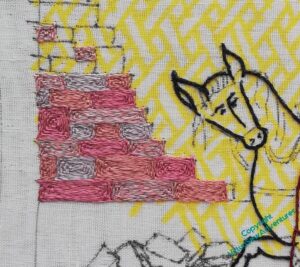
I’m keeping to the close tones I chose, using two of the three possible blends, and two solid colours. I think that is working well to represent the assorted colours in Cheshire sandstone, while being pale and pulled back, not dominating Aethelflaed but allowing her to dominate instead.
I have been quietly, methodically, choosing a silk, stitching my square spirals, stitch by stitch and block by block, thinking only to raise the remnants of the Roman Walls so that Aethelflaed can restore them.
And then, last week, I was blamelessly stitching my blocks, when I looked at my design with a new eye, and suddenly I have a thought to think through.
Notionally, for me, Aethelflaed in this design is outside the walls, touring the building site, as it were. That’s one of the reasons that I made the wall more than head-high on the rider. However, last week it suddenly seemed to me that visually, that high wall was blocking Aethelflaed’s view, and I’m not sure I want that.
Fortunately, I have all the rest of the silk embroidery, including the borders (still not entirely designed!) before I need to be certain of my decision.
Not quite starting over…
Well, what with putting her away over Christmas and then taking some time to make a decision about what to do next, it’s been a while since you saw Aethelflaed..
And here I am, snipping and snipping away at all of the wall outlines, the blocks I’d already stitched, and even the pile of blocks ready to be reused.
All gone!
And now, the section behind her and her horse is reinstated, using a mixture of blends and a couple of single colours. The tones are much closer together than they were originally, and I’ve also chosen not to use the dark outlines and dark “mortar”. This will help to create a more subtle background, while still having the pinky-orange of Cheshire sandstone. I’ve seen all these colours in various bits of Chester’s Walls – I’ve just chosen, this time, not to include the much darker browns and plum colours which are also there.
So much of representational art, whether it be painting or embroidery, comes down to a question of editing. What do I want to emphasize? What do I want to play down? How can I balance the colours, the shapes, the patterns, to tell the story I want to tell?
Looking at the newly worked section from further away, I think I’m happy now that the wall will pull back as I need it to.
Now I just need to keep going!
Having Doubts…
You may recall that I became concerned about the wall and the colours beside Aethelflaed’s riding dress. I filled in some stones, and had even more doubts.
Cheshire sandstone is an absolute horror to depict in stitch or paint – every time I’ve tried in the past I’ve missed in one direction or another. So I’m not especially concerned that this version is proving exasperating too. I just need to find a way to create something I can live with. And indeed, something that Aethelflaed can live with!
The sensible thing seemed to be to do the back panel of the dress and then look seriously at the combination. So here we are, back panel of the dress, including the bright, dramatic, interlaced pattern on the border.
I do need to retweak the highlight on the skirt, somehow, but I have dress and the border in place, and I think the wall colours are definitely going need a bit of tweaking.
So with the idea in mind of blending colours to make the walls sit back from Aethelflaed a little more quietly, I did some experimentation.
Now I have to make some decisions, of course!
Aethelflaed Begins to Progress..
The first stage is to outline everything, so here goes…
Since a white veil would have been an important part of the outfit, I’ve made sure the shadows are outlined in blue. That will make the white seem whiter, making the day seem sunnier.
I’ve given her mittens, rather than gloves – that may be cowardice (no fingers to do!) – but it will make for simpler shapes. How much the Medieval Movers and Shakers will wander from a truly medieval style and sensibility, I don’t know as yet, but I’m trying to keep my wanderings within reason.
Anyway, here we are, all principle outlining completed.
It barely shows, but the stones are outlined using three different shades of dark brown. It shows a little more in real life, and it might helpd to create slightly different impressions on patches of stonework. We’ll have to wait and see about that!
I’ve left the horse’s headstall and harness unstitched – I’m going to stitch that over the top of the main horse stitching.
I’ve not really tackled the grass, even in thought. I’m intending to make it tussocky – another contrast with William Marshall, approaching his kinsman’s well-kept castle, with undergrowth kept back from the walls. But how – I’ve no idea as yet!
I have another problem, anyway. I’ve started to put the walls in, and I’m more than a little concerned that the contrast of the stonework, if I continue like this, is going to be much too high, pulling the wall forwards and dominating the picture.
I can’t have that – Aethflaed is the one I want people to see. Her work comes after her.
So now I’m wondering about blending the colours to soften the change. That feels like a rather un-medieval thing to do, somehow, so I have to decide whether that’s a point I’m willing to concede.
Raising A Needle At Last
Having at last settled on a design for Aethelflaed, there was a certain amount of jockeying around to get the size right and everything in order to start stitching.
As you can see, I’ve got William prepared to be mounted, but he’s still unmounted, which makes him easy to compare. The direction of the designs are contrary, there will be more red and brown in Aethelflaed, and I think the white horse will be rather necessary to help lift it.
You will see that I’ve already added the guidelines for the planned basketweave underside couching. I found adding them later really nerve-wracking, so this time I put that in first, and then the important bits of design went over the top, in a different colour and more precise line..
I was able to gather some of the threads from among those I used for William, which has helped. Partly because it’s always good not to have to buy more than you need, but also because it will help the series “talk” to one another if the palette of colours has some continuity. And then some of the others were passed on to me by Sue from TortoiseLoft (thank you, Sue!).
It has occurred to me (very recently) that if I keep the same blue background in the border, that will also keep the conversation going among the designs. I’m also considering winding the roses around the barrels and skeps, again to keep the conversation going.
But finally – FINALLY!! – I’ve managed to get started!
I’ve used three different browns in the outlines of the stones of the wall, and a very dark blue-grey for the horse.
There’s much more to do, but my goodness, I’m glad to have begun. I know Aethflaed must have been feisty but her embroidered representation has been living up to every bit of it.
Now, what would she have called her horse?
Getting there at last…
Definitely getting there now. The horse is madder (a bit), and shorter-backed. I think when I stitch it, I may give it a clipped, standing mane, instead of the flowing locks – another contrast with William Marshall’s horse Mars.
Aethelflad herself is taller, and the contrast is closer, in keeping with the idea of wearing a sensible woollen riding dress to visit a building site.
I’m not sure about the saddlecloth – that may be something I will choose not to include.
I wonder whether Prior Rahere and Mother Julian are going to take as many iterations?
I think I’ve got it now.
I’ve added a border, and decoration around the neckline of the dress, both of which have helped. And I’ve cut out the pile of building stone and Aethelflaed herself, and moved them around a bit to make a layout I’m happy with.
Gosh. It’s taken a while!
Second Trapunto Jewel
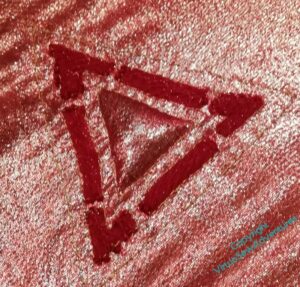
We left the second trapunto Jewel looking like this: crimson gauze over gold tissue, with red wool stuffing the outer, broken channels in the gauze, and something stuffing the central triangle from behind the gold tissue.
And it looks like a good start, doesn’t it?
But some of my more alert readers may be thinking, hang on, didn’t you say something about doing the narrow gold channels first?
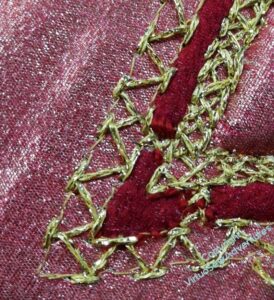
Well, yes, I did, but that was when I was filling the channels trapunto-style. I decided to try something else for this next one. I used a gold metallic chainette yarn – the same for all of the gold stitching – and after some thought, picked interlaced Cretan Stitch, to create some of the effect of punched or engraved gold surrounding the gemstones. At this point you can see I’ve only done the first part of the outer line.
I had to invent something for the short sections joining the outer and inner triangles!
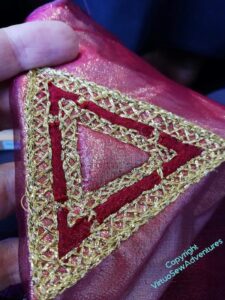
Finally, I decided that the edge needed a bit of help and ran a line of chain stitch around the outside.
In terms of the effect, I think this is a great success. However, I’m not sure this is the right scale for Aethelflaed (in terms of size it’s an appreciable fraction of her finished size) and the gold chainette was a bit of a pest to work with. I was stitching in public, so no swearing.
There was, however, muttering…..!
More Planning for Aethelflaed
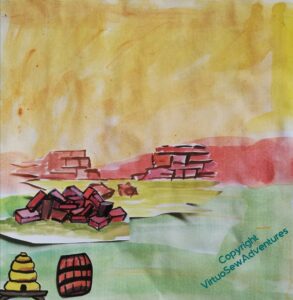
As I have thought about Aethelflaed and begun to plan the design of her panel, I’ve also begun to plan what the background will look like.
Brought up, as I was, in Chester, the obvious point in her life to choose is her defense and refortification of Chester. So the stone for the wall is the distinctive dark pinkish sandstone of Cheshire, and in reference the the beehives and boiling beer turned on the Viking assault, I have a barrel and a bee skep ready for deployment.
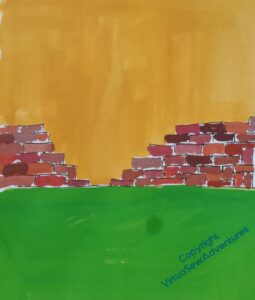
But I need something that I can try to place Aethelflaed against, and strong enough in colour to give me a start on picking her colours, so I’ve redone some of it to give me something to work with. Although I do feel that maybe the wall isn’t high enough.
While I’m working on the walls of Chester, I also need to work a bit more on Aethflaed and her horse. The pair of them are proving much trickier than William, mostly because examples of horsemen aren’t hard to find in medieval art. I only had to decide on a few tweaks of presentation and insert the appropriate coat of arms. Aethelflaed is being invented as I go.
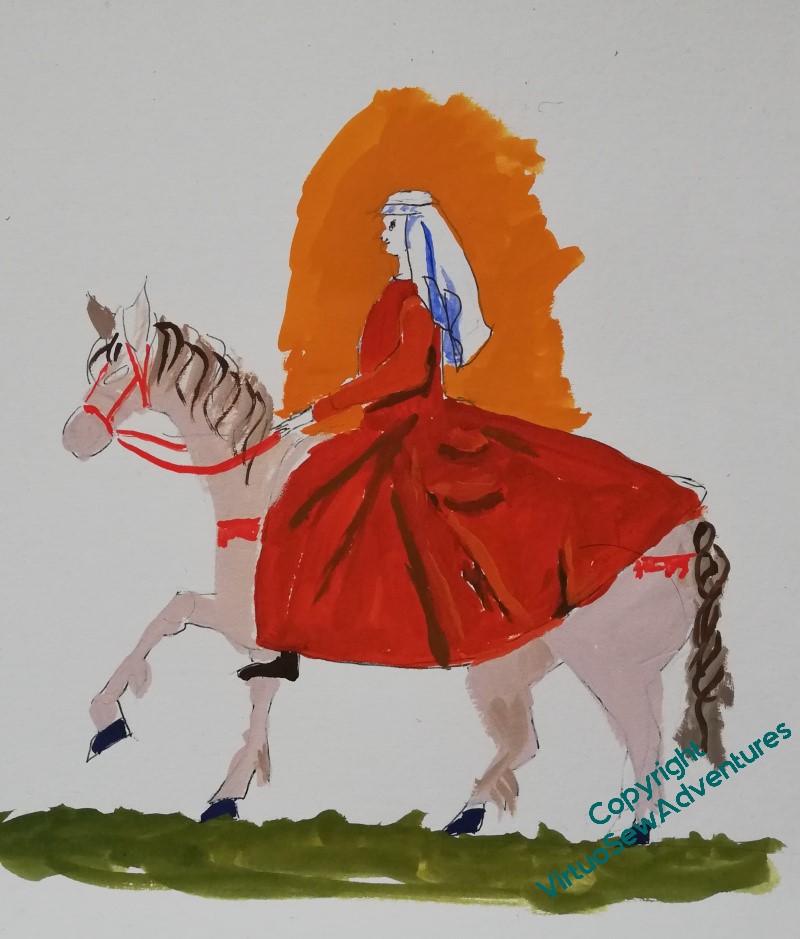
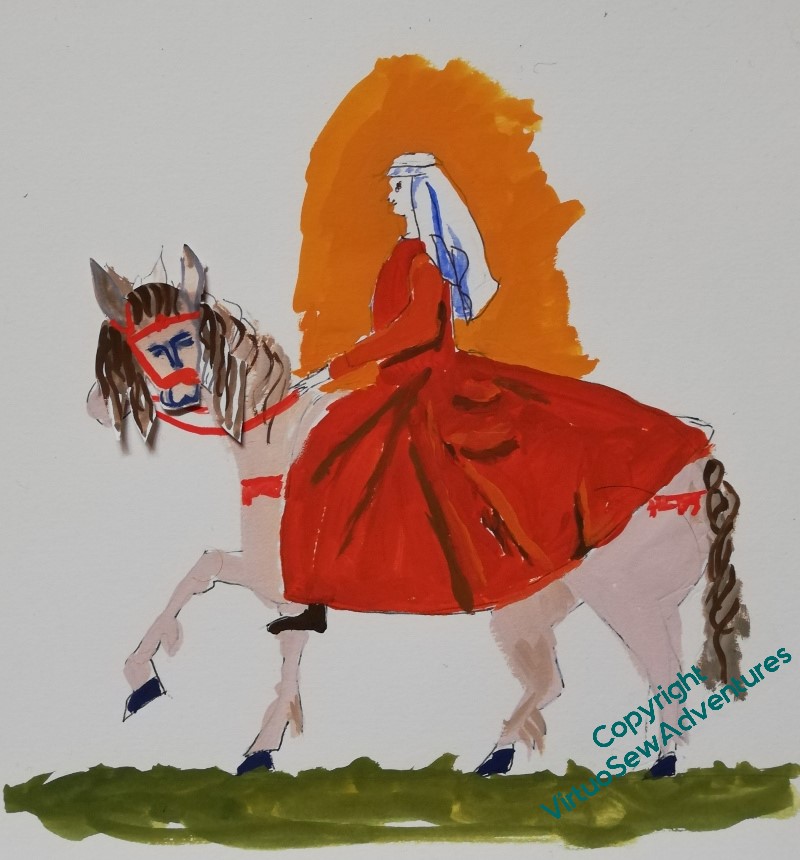
In fact, the invention, reinvention, and re-reinvention continues! I think the horse has become a little too long-backed, and needs to be a bit madder. And I’m not sure that Aethelflaed is in suitable proportion to him. What I might do is go back to the original horse, and indeed, the original lady, and then work forward (yet) again, using all the information I now have.
All this planning is keeping me from stitching, and I’m getting twitchy!

